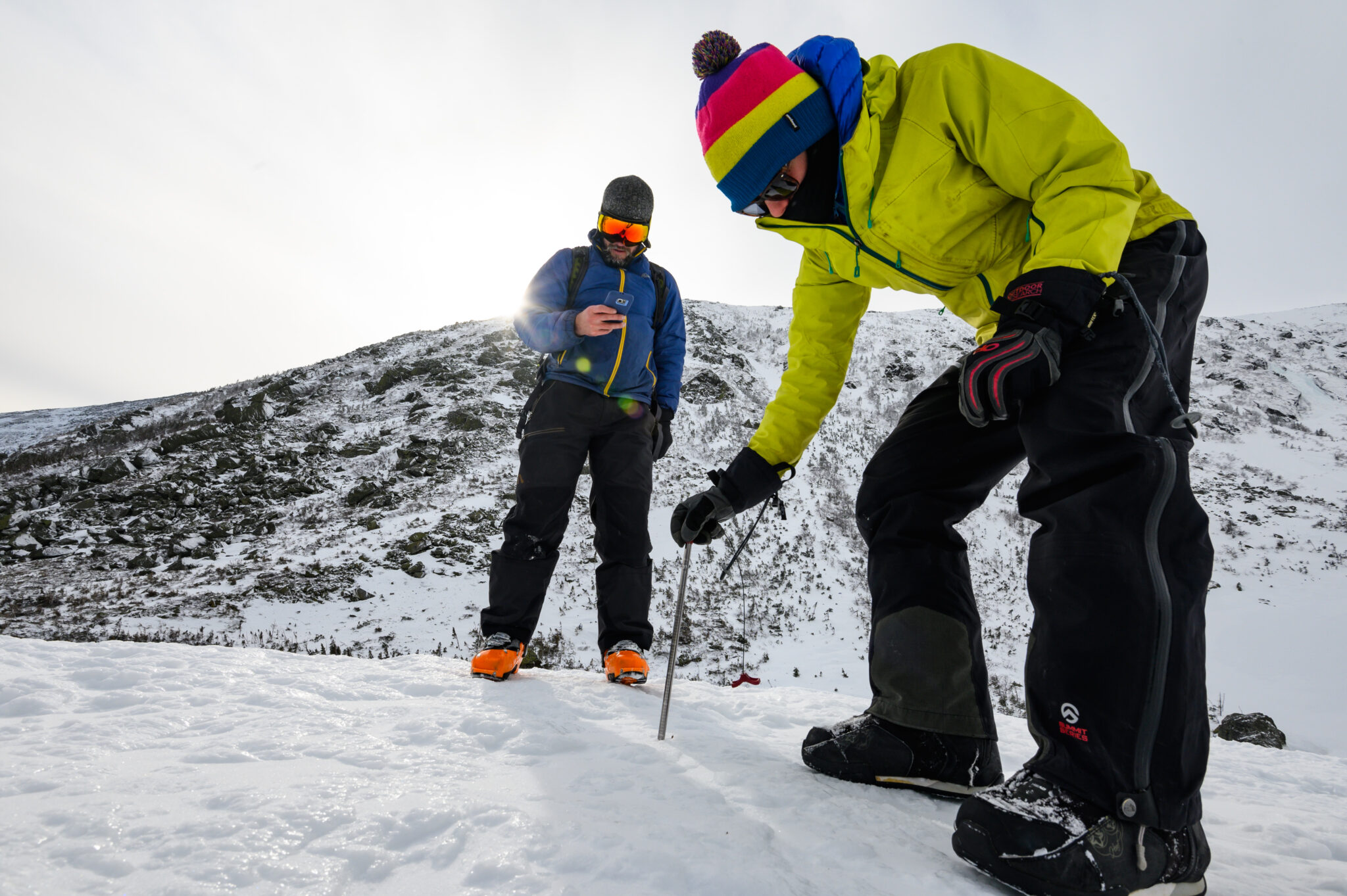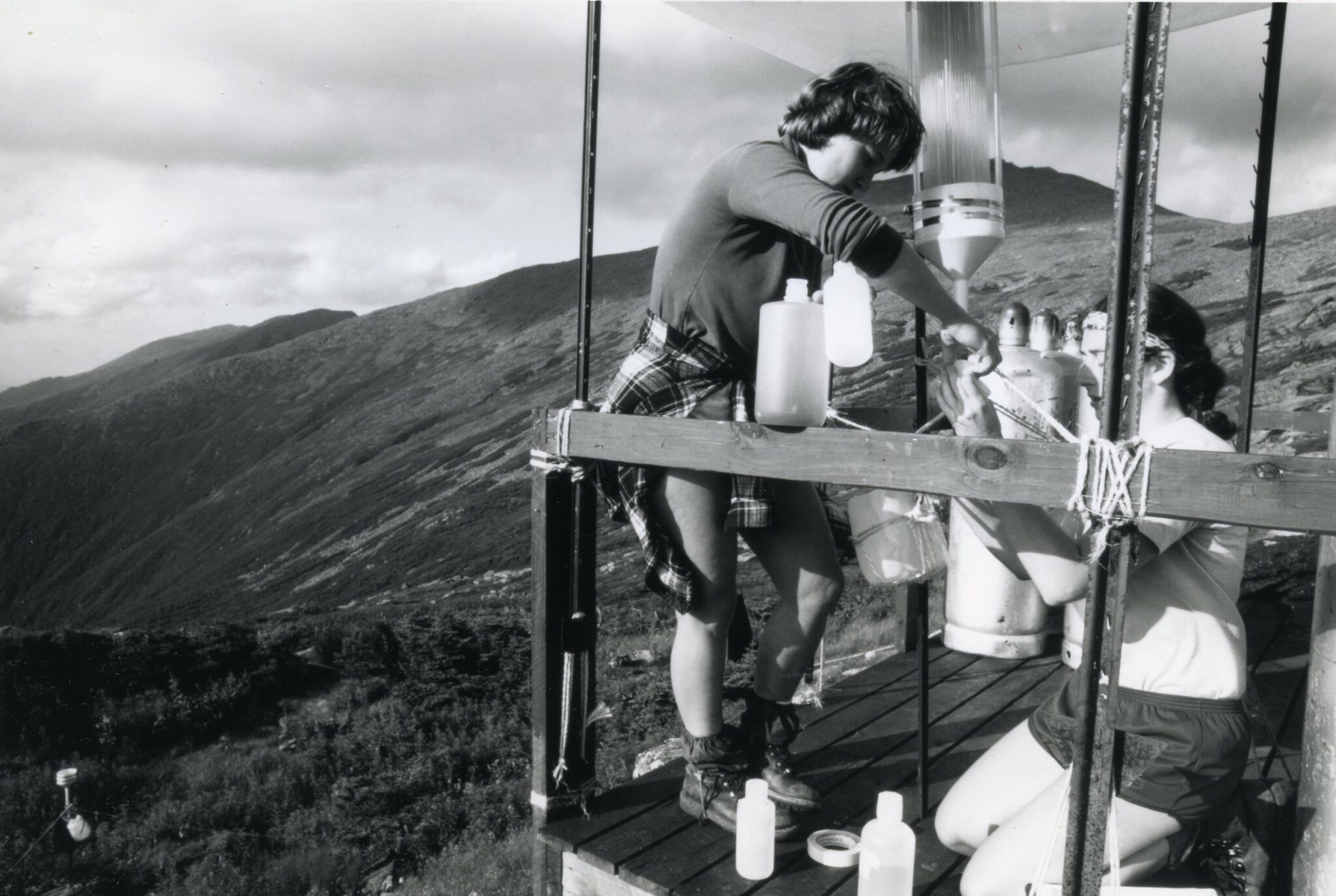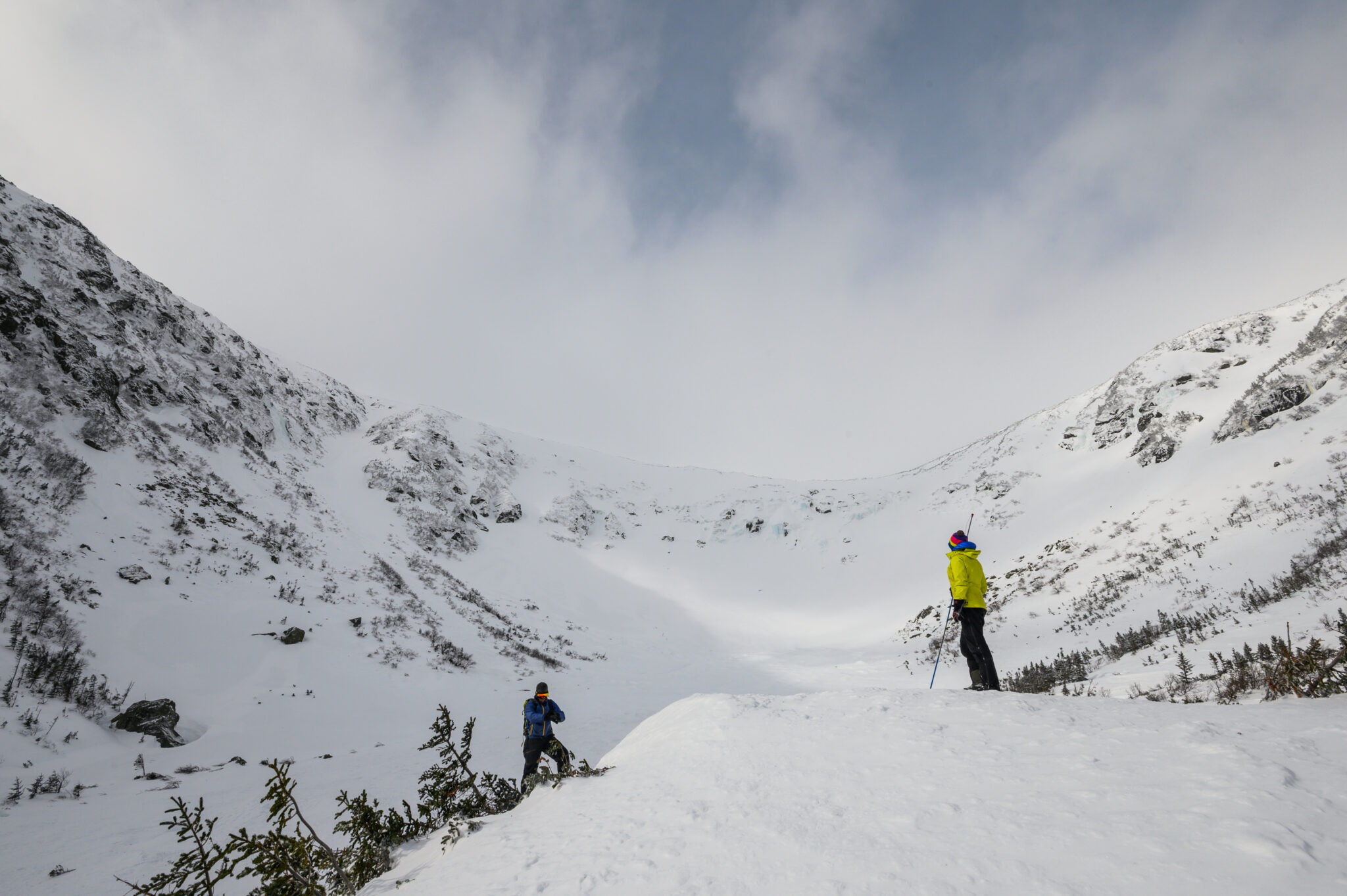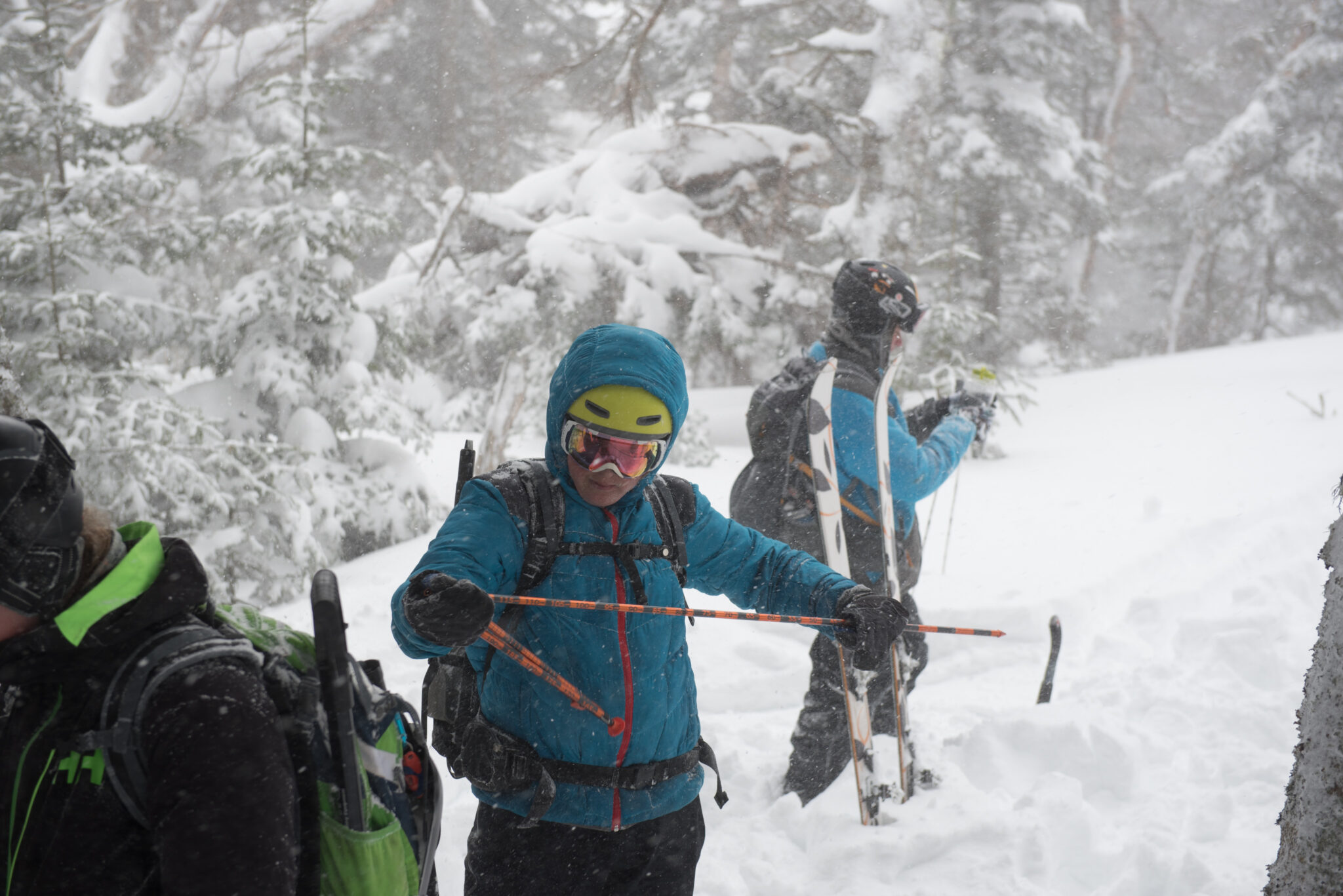
Citizen scientists measure snow depth during a day in the backcountry.
It’s 5:30am. The sun hasn’t risen over Mount Washington, but AMC Hermit Lakes Winter Caretaker Eli Hanschka is already out in the cold, looking at snow.
Each morning on the job begins this way for Hanschka, and for many of his fellow caretakers. From his cabin, Hanschka walks a short distance to his “snow plot,” a 30 square foot area set aside for scientific snow observation. Once there, he’ll measure the snow’s depth against a stake in the ground, record the snow’s grain form and size, the amount of melt since the previous day, and a 24-hour snow total. There’s a thermometer that he’ll use to record the snow’s temperature at multiple depths and a scale to measure a flake’s “snow water equivalent.” He’ll also write down some general observations about the weather, including the sky’s condition and wind direction.
All of this, and more, is completed by 6am, at which point Hanschka radios his findings to the Mount Washington Avalanche Center. Hanschka’s snow plot sits at the base of Tuckerman Ravine, one of the most popular backcountry skiing destinations in New England. His daily contributions help the Avalanche Center create forecasts of potential risk.
The data Hauschka collects isn’t just for these essential reports, however. AMC’s Research Department is combining these daily observations with data from Community Snow Observations, a non-profit program that pools user-submitted snow data from “citizen scientists” across the country, and the world. The initiative is aiding AMC scientists in their work to understand how winters in the White Mountains are changing, and what that means for everything from avalanche safety to the unique plants and animals that call the region home.

AMC has been monitoring climate change in the White Mountains for decades. In this photo from the 1980s, a research assistant measures air quality at Lakes of the Clouds Hut.
Fill In the Gaps
At the helm of AMC’s efforts to harness community snow data is Staff Scientist Georgia Murray. Murray’s research has long focused on climate trends in the White Mountains. The region’s high summits, once thought to see limited impacts of climate change compared to the rest of the Northeast, looks very different than it used to. In 2021, Murray published a study based on decades of data from the Mount Washington Observatory and AMC observations near the Pinkham Notch Visitor Center, at the base of the mountain.
The findings: temperatures are up on New England’s highest peak. In all, the area has lost more than two weeks of frost conditions in just 84 years.
One climate variable that is harder to monitor is snowfall. Mount Washington’s summit is home to some of the strongest winds in the world, and snow doesn’t always stay in one place long enough to be accurately measured. By working with Community Snow Observations, Murray and her team have an opportunity to better understand snowfall trends at high elevation and across the region. Ideally, observations will come from places like Pinkham Notch, where it can be compared to historic data, and new parts of the White Mountains that are too remote for Murray’s small team to regularly monitor.
“Where we see this data set helping is filling in, because we can’t be everywhere. By relying on crowdsourcing, we’re hoping to fill in the gaps,” says Murray.
With more data to pull from, AMC’s Research team and scientists at several partner organizations will be able to improve snow cover models, and eventually the climate predictions that inform science-based policy changes. For Murray, this work is exciting because it aids experts who study long-term climate issues and also helps wintertime outdoor enthusiasts stay safe.
“I think that by improving those models, we’re going to improve overall safety and other types of information that rely on snow models, like hydrological models related to snowmelt timing and potential flooding,” says Murray.

Tuckerman Ravine is one of the most popular backcountry skiing destinations in New England. Snow data from the area helps to forecast avalanche risk.
How It Works
Community Snow Observations citizen scientists can be anyone heading outdoors in the winter. Getting involved is easy. The only additional gear needed is a smartphone and either a ruler or avalanche probe.
“It’s a super simple free app. You just make an account, hit a little plus button, and then take your measurement,” says AMC Community Science Intern Valerie Neuhausser, who’s been working with Murray to gather and analyze snow data.
Here’s how it works:
- Download the Snow Scope app.
- Turn on location in your mobile device to help ensure your observations are dated and accurately geo-tagged.
- Click the orange ‘plus’ button at the bottom of your screen and select “Snowpack Height.”
- Take three snow depth measurements, measuring in centimeters, using your ruler or avalanche probe.
- Calculate the average of the three measurements and record the average.
- Select “Save.”
Neuhausser recommends finding an undisturbed area and taking three measurements to account for snow drift. Besides that, any spot is fair game.
“It takes probably two seconds of inputting into your phone. And that’s good, because your hands are going to get cold when you’re out there in the winter,” says Neuhausser.

AMC Director of President’s Society Mark Cheever demonstrates how to make a snow observation.
“Training the Trainer”
While Community Snow Observations has been active in ski communities across the Mountain West since 2017, it’s relatively new to the White Mountains. AMC has been a leader in building the program up in the Northeast and increasing interest and participation.
AMC scientists are using a “train the trainer” approach, enlisting the help of community partners who can educate large groups. Murray and staff are also counting on contributions from AMC staff working in the White Mountains. AMC’s Research Department, the U.S.Forest Service, and the National Weather Service have all helped to train AMC winter caretakers on measuring snow depth and collecting other data points.
Another part of the puzzle is Community Snow Observations’ own citizen scientist ambassador program. This initiative enlists members of the outdoor community to spread the word. As a professional photographer, avid backcountry skier, and board member at the Mount Washington Avalanche Center, Joe Klementovich has worked to engage his fellow skiers as data collectors. According to Klementovich, one of the program’s selling points is that the information they submit can make a real difference to understand and protect their beloved winters.
“I think people get excited when you start telling them that they’re not just doing this as like a fun science project, but it actually gets pulled into the data and then the model gets revised and corrected.”
For Klementovich, going from playing in the mountains to also gathering data has felt natural.
“Most of the winter I’m in the mountains, and it seems like a no-brainer to collect data at the same time,” says Klementovich, in a profile from Community Snow Observations.

A skier uses an avalanche probe to make a snow observation.
Taking Action
Ultimately, snowpack data from the White Mountains and Western U.S. tell a similar story: winters are getting shorter, with warmer average temperatures and fewer snow days.
For backcountry skiers who flock to Tuckerman Ravine, it could mean fewer predictable snow days. Rapid fluctuations in temperatures can also increase avalanche risk.
Shorter winters could have many serious environmental consequences, some still unknown, according to Murray. Lower snowpack runoff in the spring means less water for plants. Warmer overall temperatures could also impact some of the rare species in the White Mountains’ alpine zone, which thrive in harsh winter conditions. AMC scientists are already studying the way climate change impacts alpine plants’ flowering times through another citizen scientist initiative called iNaturalist.
The next step is engaging more of the community in collecting snow data. While working with partners in the White Mountains has been the focus, Murray hopes to see Community Snow Observations expand to other parts of the Northeast. AMC and its partners will also take the conclusions drawn from this research and explain them to advocates and policy makers alike.
“When we have those opportunities to engage our membership [in conservation advocacy], we often talk about the research we’re doing on the ground,” says Murray.
Ultimately, Murray hopes AMC’s snow research will resonate far beyond the White Mountains and inspire a more robust effort to reduce the greenhouse gas emissions that cause climate change.
“[The research] is linked from the perspective of direct action to address climate change. If we’re losing two weeks of snowpack at the Pinkham Notch, that is a direct impact from greenhouse gas emissions.”
It’s a message we can all take to heart, whether we’re trying to stay safe in the backcountry, keep the planet healthy for the next generation, or just love seeing the first snowflakes on a cold winter day.
Want to make your voice heard on pressing conservation issues? Join AMC’s Conservation Action Network (CAN).